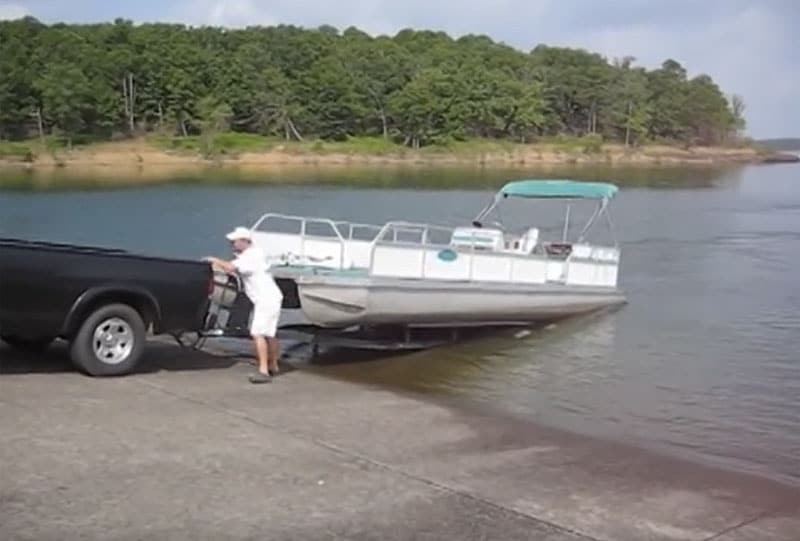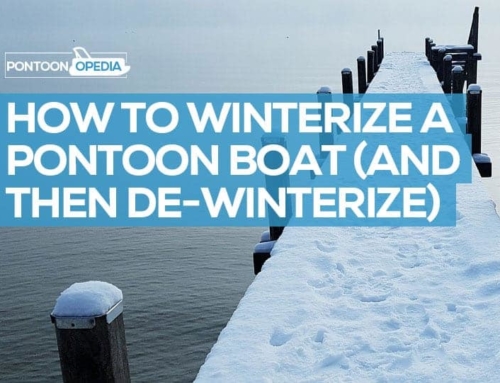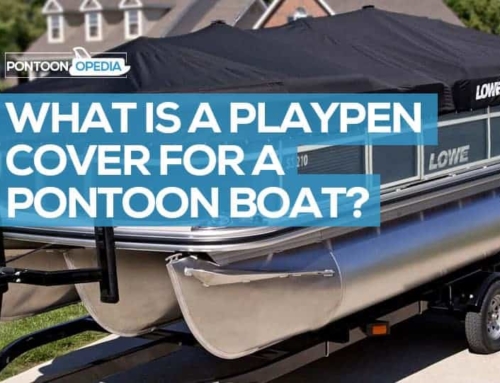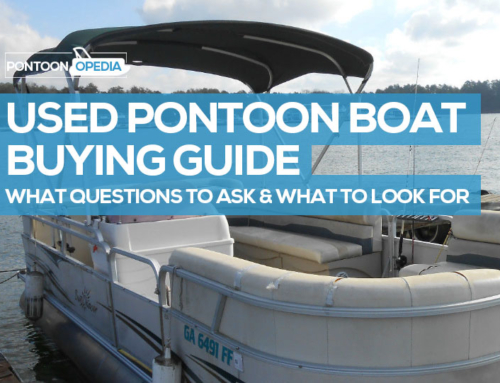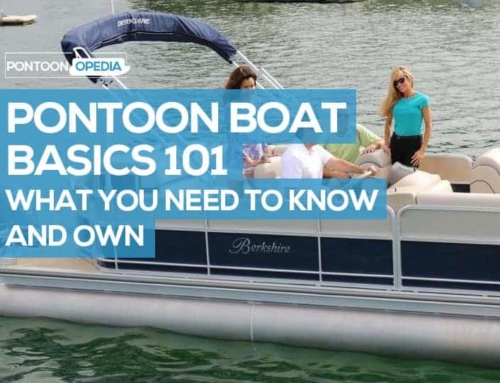You’ve just bought your first ever pontoon boat… congratulations! But now the hard work starts, and none more so than learning how to master trailering your boat.
The first time I ever trailered my pontoon, I was worried.
I’d never done anything like this in my life before, let alone something the size of a 22-foot Bennington. But, as with most things I overcame the fear and got straight into the saddle and decided to learn as a I went along.
Whilst you might think that an admirable approach, perhaps I should have done some research beforehand, as I ended up having quite a few bumps and scrapes along the way.
I don’t want you to do the same and would much rather that you learned from my pontoon trailering mistakes. I’ve definitely learnt the hard way but have compiled all of my rookie errors below.
How to Take a Pontoon Boat Out of the Water
Read these 11 tips for pontoon trailering before you even consider getting trying to get your boat out of the water and back onto your trailer.
1: Watch and Respect the Weather
I know how tempting it is to stay in your pontoon for as a long as possible, but if you see high winds or a storm approaching, it’s time to get out of the water.
When it’s very windy, your chance of successfully trailering your pontoon boat is vastly reduced. They tend to catch the wind and the elements will show no mercy whatsoever!
The design and layout of a pontoon boat makes them very susceptible to being pushed around by wind. In worst case scenarios you might have to swallow your pride and call upon the help of other people at the dock to get your pontoon into the right position.
Knowing how to get a pontoon boat out of the water quickly and easily in particularly important when the weather starts to turn.
2: But the Wind Can be on Your Side Too
Wind isn’t always a bad thing, and in fact can be used to your advantage when trailering up.
If you’re loading up on a windy day, you could start with your pontoon parallel and upwind of the trailer. With a little careful positioning, you can let the wind help you get into the correct approach line to the trailer.
Fast forward to around 3 minutes in on the video below, and you will see this pontooner using the wind to help push his boat into line.
Despite the windy conditions, he is still able to have the control, steering, and speed that he needed at all times.
3: Use a Dock Hook to Push and Pull into Position
Dock hooks are amazing, and even more amazing is how many pontooners don’t own and use one to help with trailering. It’s an essential accessory, and if you don’t have one, go buy one today. Here’s the dock hook I use on Amazon.
It’s telescopic with a hook on one end. Where it comes in handy is you can hook onto the docking cleats and pull your boat back into place, even if the wind is pushing you about on the water.
4: Use the Dock to Break the Wind Flow
Another way in which you can use wind to your advantage is to get downwind of the dock. Ask the driver to get the trailer up close and on the downwind side to counter act the waves and wind.
By doing so the dock can help to break up some of the waves and wind that could be buffering up against your pontoon, making it hard to keep stable during trailering.
Combine this method with the dock hook I recommended in the previous tip, as you can then pull the back of your pontoon over to the docking area so it doesn’t drift.
5: Have Passengers Come Off the Pontoon
The more your boat weighs, the harder it will be to trailer up.
The easiest way to get the weight down is to ask your passengers to step off if possible, providing that it’s safe to do so of course. If they can’t leave the pontoon safely, instead ask them to move from the front to the back.
By doing so you will be able to use less engine thrust and power plus won’t have as many visual obstacles in your line of sight.
6: Take it Slowly and Don’t Go Too Deep
Judging how far you need to back the trailer into the water is one of the hardest things to initially master when starting your first ever trailering experience.
For the first three or four times I actually ended up going too deep which meant my pontoon boat was still floating, even when it was on top of the trailer.
To fix this issue, back up down the ramp and get the trailer in just deep enough so that the wheel tops are barely under the water. The easiest way to do this is to pull the trailer back just enough so that the wheels get wet.
Once you’ve done that, bring up the front of the pontoon and ask the vehicle driver to then go a little bit deeper. This way you should be able to drive the pontoon all the way up the rest of your trailer.
7: Use a Pontoon Trailer that has Guide Rails
You probably had a trailer thrown into the deal when you bought your pontoon, and with any luck it has guide rails already fitted.
If you don’t have guide rails, then I recommend you check them out when next at the dock as there is bound to be another boater who has a trailer like this.
For beginners, or anyone who has problems trailering their pontoon boat, it can be a great help. But obviously, upgrading to a new trailer is expensive so you need to weigh up the pros and cons.
But how do guide rails on a trailer help?
Well, for starters, your stress will be greatly reduced, simply due to the way in which the guide rails help you get the best load each and every time.
It will help you to see the correct depth at which to submerge the trailer, plus let you straighten the pontoon up better so it slides straight on, and hopefully first time!
Here’s another tutorial video below where you can see this guy trailering up his pontoon boat despite approaching at a tricky angle. I really do recommend that you go and check out prices for a new trailer with guide rails if this is something you struggle to do properly.
As you can see in the video, even boats coming in at an angle are able to trailer easily. For this reason, docking trailers with guide rails are a great way to ensure a successful load or launch every time. If you’re a beginner who’s intimidated by the process of trailering your boat, these trailers can make you look like a seasoned pro.
You Can Buy Trailer Guide Rails Separately
Alternatively, it is possible to purchase guide rails that can be retrospectively fitted to an existing pontoon trailer.
If you don’t want to buy a new trailer, you can install guide rails on your current trailer. There are a number of different installation kits available on the market. One that I have seen for less than $100 is the Extreme Max pontoon trailer guide-ons.
8: Invest in a Scissor Trailer Instead
An even more expensive solution, albeit one that could really help you with pontoon trailering is to use a scissor trailer. These are far easier than standard bunk trailers when it comes to trailering, as they are specifically designed for pontoon boats.
Whilst bunk trailers are better for driving on the road, they aren’t as easy to load. You need to weigh up the pros and cons and decide if it’s worth the additional investment.
Scissor trailers have a lower wheel base compared to bunk trailers and are very good in shallow waters – in other words, such as the shallow water you would encounter when trailering at a dock.
But scissor trailers can be prone to swaying and flipping at high speeds or in high winds when driving, so you will need to take extra care when transporting your boat.
9: Learn How to Launch Properly
Trailering a pontoon is just one part of the process. How you actually get the boat into the water in the first place is just as important, and can be just as tricky.
I would always recommend that you have two people at minimum for launching; one driver, and one person doing the manual work at the boat. But it is possible to launch a pontoon by yourself, and in fact, I’ve put together a guide on how you can do that.
Regardless of how you do it, learning how to do it safely and quickly is going to be one of the key skills you need to master as a pontoon boat owner.
10. Practice Makes Perfect
As with any new discipline, the more you do it, the better you will get.
My advice is to get out there when you know it’s going to be quiet at the dock, and get some practice in when you know the traffic levels will be less than usual.
A popular technique for trailering is to use the two-handed method when backing the truck down the ramp. By putting both of your hands at the bottom of your steering wheel, you then turn the wheel in the direction you wish your pontoon to go.
This simple hack makes trailering up a pontoon so much easier, meaning you can keep the right approach angle and reduce the chances of veering off course. Go try it and get some practice in.
11. Make the Proper Checks Before Driving Off
Once you have trailered up your pontoon boat, make sure you do the basic checks to ensure that everything is ok to go before you hit the road.
Those tips of things you need to check include:
- Vehicle and trailer tire pressure
- Trailer lights are working
- Trailer hitch is locked properly
- Pontoon is strapped on securely
- You’re not exceeding the trailer weight capacity
- You have the right insurance
- You know the trailer speed limits in your state
- You drive with cover or without cover on depending on the type
Handy Hint: Click here to read my essential tips for towing a pontoon boat including safety advice.
Conclusion
If you are new to pontoon boats, don’t let the trailering aspect become the elephant in the room. Learning how to take a pontoon boat out of the water needn’t be hard. The sooner you embrace the challenge and get out there and do it, the easier it will become (providing you have the right trailer – see some calculations).
I promise you that after three or four attempts, you will have it down to a tee and will wonder why it made you so anxious in the first place.
Expect to make some mistakes, but unlike me, you now have these pontoon boat trailering tips which I hope will stand you in good stead straight off the bat.

